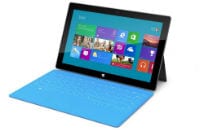 As an increasing number of businesses deploy mobile applications, there is more discussion of which OS to choose for rugged tablets. This is happening for a variety of reasons, including the need to integrate tablets and other mobile computing devices along with increasingly sophisticated applications across the enterprise. Many businesses today are examining, if not actively considering, Google’s Android platform as well as Microsoft offerings.
As an increasing number of businesses deploy mobile applications, there is more discussion of which OS to choose for rugged tablets. This is happening for a variety of reasons, including the need to integrate tablets and other mobile computing devices along with increasingly sophisticated applications across the enterprise. Many businesses today are examining, if not actively considering, Google’s Android platform as well as Microsoft offerings.
Microsoft’s Windows OS has the largest market share of established workforce, especially in the rugged computing space. Although Google’s Android platform is still nascent in the enterprise, the growing demand for Android is driven by innovation and new application development. Yet enterprises may be reluctant to adopt and implement these newer platforms because of security, support, and other challenges. Many businesses find themselves asking: Which one should we choose?
The Case For Windows
 Tablets that operate in the standard Microsoft environment enable corporate IT departments to utilize well- established management protocols. The task of trouble- shooting efficiently and protecting against viruses is often done remotely — an important consideration with a dispersed, mobile workforce. Since IT departments have greater familiarity with the Microsoft environment and appropriate remote diagnostics, they are able to more easily walk mobile employees through what needs to be done should a problem arise in the field. This translates to a more productive workforce, keeping costs down. As well, a bigger pool of third-party developers continues to create a large number of Windows-based applications and tend to do so more than with a newer OS.
Tablets that operate in the standard Microsoft environment enable corporate IT departments to utilize well- established management protocols. The task of trouble- shooting efficiently and protecting against viruses is often done remotely — an important consideration with a dispersed, mobile workforce. Since IT departments have greater familiarity with the Microsoft environment and appropriate remote diagnostics, they are able to more easily walk mobile employees through what needs to be done should a problem arise in the field. This translates to a more productive workforce, keeping costs down. As well, a bigger pool of third-party developers continues to create a large number of Windows-based applications and tend to do so more than with a newer OS.
Additionally, there is a trend to move from single- purpose devices to multiuse computers that extend the desktop into the field. If you are attempting to push standard email along with viewable, editable, and usable documents, then the interface with Microsoft Office programs should be considered.
The Android Option
The Android platform is growing, and businesses will see a slightly lower device cost. Another advantage is the ability to deploy applications directly from the “application store.” Android affords more flexibility and customization options to developers; however, at this time a smaller Android developer community is generating fewer high-level business applications. Developers also are challenged with attaining support for older Android OS versions, even though there have been numerous upgrades and releases.
To read the full article, visit Field Technologies Online.
More: Top Tools to Train Your Techs on the Cheap.
Click here to download a free whitepaper, “Five Steps to Make Field Service Profitable.”

Share this: